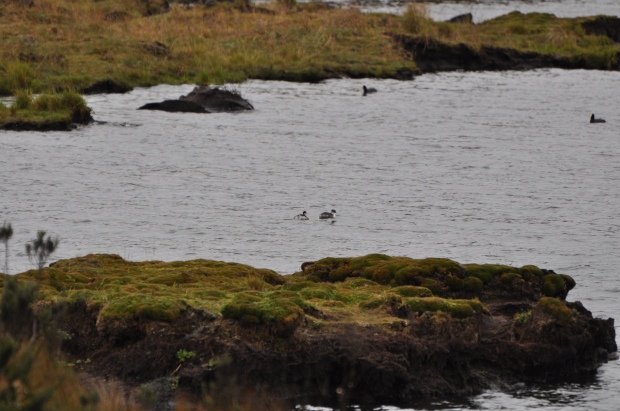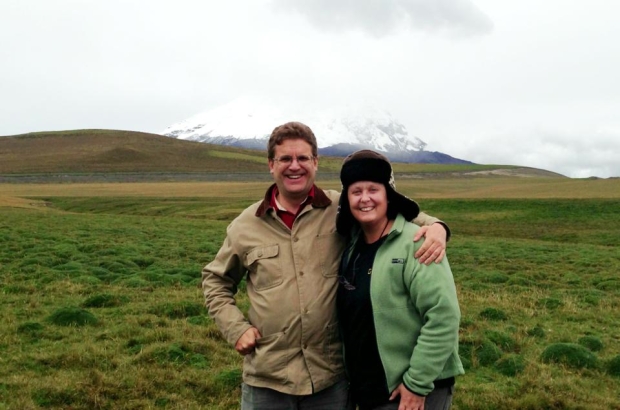Birding Antisana feels a lot like Scotland. Yes, really.
We were right on the equator but if I didn’t know any better I would have thought we were in the Scottish Highlands. It was as though we had been swept away to Scotland—that same country where Steve and I first met and rendezvoused seven years ago.
But no, we were still in Ecuador, at Antisana Volcano Ecological Reserve. Where I should have been hearing Andean flutes in my mind I was instead imagining bagpipes.
So as my mind was playing back our first romantic rendezvous from seven years ago, I took in the pristine landscape, the sweeping gorges and the mountains (and volcanos, of course) jutting up from the earth. Ah, Scotland, how come you never told me you had a cousin called Ecuador?
And with mountains and valleys you’ll also find a lake with waterfowl that you would never think to find at 18,000 feet. Like these Silvery Grebes. Grebes, I tell you! At 18,000 feet!
And Andean Coots. And the Andean Ruddy-duck. It almost seemed crazy to see these guys clear up here.
We drove along in the van with our guide and driver from Tropical Birding, and in the distance we saw the beautiful Carunculated Caracara. It was exciting finding him. We turned the corner and there was another about 50 feet away, and again we were thrilled. After every turn in the road we saw a Caracara and then it seemed like there were dozens of the raptors. It’s funny how it happens that way. You get a little giddy by seeing one, maybe two or three and then they seem to be everywhere. (You just feel a little stupid once you realize they’re all over the place at Antisana. But then again, as the Accidental Birder, most of my experiences birding make me feel sort of stupid.)
It didn’t stop there. Also dining on the worms are the Black-faced Ibis, which were found at every turn, and there were also Andean Gulls, which I think are pretty cool looking with their black masks. Antisana is such a birdy place that it almost felt too easy to go birding. (Can’t all birding excursions go this well?)
Know before you go
We were able to drive through all of Antisana when we visited, but that’s not always the case. It seems as though when we visited that the Reserve didn’t want cars going through. We made a clever convincing argument and they allowed us to drive through to the lake and back. Hopefully the Reserve will change its policy regarding cars, especially for birders who often are the most conservation-minded folks on the planet.
Also, when you go to Antisana, be sure to dress appropriately. You might be near the equator and think that all of Ecuador is hot, but you are at 18,000 feet and it gets cold up there. You know, a lot like Scotland.
More photos!
Click on any photo below and it will take you to a gallery of more photos from our trip to Antisana Ecological Reserve, include a couple more birds I didn’t mention above.
- Volcan Antisana
- Andean Gulls
- A view of Pichincha Volcano from Antisana Volcano Ecological Reserve
- Black-faced Ibis
- Black-faced Ibis
- Lichen on a rock at Antisana
- Antisana Ecological Reserve
- Plumbeous Sierra-Finch
- Andean Coot
- Silvery Grebes
- Andean Ruddy-duck
- Antisana Volcano Ecological Reserve
- Carunculated Caracara
- Black-winged Ground Dove
- Yellow Calceolariaceae flowers (The locals in Ecuador call them “Doll Shoes”)
Other posts about this trip
- Birds of Ecuador: The showstoppers!
- NO ONE misses the Birds of Paz de las Aves in Ecuador. Well, except me.
- What to do about that ginormous Birds of Ecuador field guide
- Tips for birders joining an organized tour
- Pressures of Ecuador
- See, taste and experience Otavalo Market (from my other blog, Baby Aspirin Years)
- Picturing Quito (from my other blog, Baby Aspirin Years)
- Angry Hummingbirds
- Come hell or high water: In search of the Torrent Duck
- We’re at bird camp
- Birding high atop the canopy at Sacha Lodge
- It’s elementary my dear Hoatzin
- I held a hummingbird in my hand today
- The tree tomato welcomed me to Ecuador (from my other blog, Baby Aspirin Years)
- The Amazon and Sacha Lodge: Getting there is half the fun (from my other blog, Baby Aspirin Years)

























Wonderful photos! Wish I was there…
LikeLike
ToughLittleBirds, You definitely should try to make a trip there. It’s a very special place indeed.
LikeLike
It does look a bit like the highlands, I agree.
LikeLike
Aw, Mr Tootlepedal, I was totally thinking of you when I wrote this post. 🙂
LikeLike
How did 18,000 feet feel as you were walking around? Weren’t you gasping for air? This is an amazing place — I’ve never heard if it. Worms?? At 18,000 feet. What are they doing there? Tell us more about this area!!
LikeLike
Antisana Volcano Ecological Reserve ranges from 15,000 to 18,000 feet. We mostly birded by car and got out occasionally to walk around. Since this was near the end of our trip and we had been in the Andes for about a week already, I finally was getting the hang of the altitude, but I was still a little slow moving. You would also love Antisana because you can see Andean Condors. We saw a pair on the cliffside and waited for them to begin soaring, but to no avail. But the following day someone told us he got good looks at the condors soaring. (Aw, rats!)
LikeLike
Definitely going to put this place on the bucket list, but will have to get in better aerobic shape first. Thanks for the info!
LikeLike
Oops, just found your earlier post on “pressures of Ecuador” and see that you were indeed oxygen-challenged up these at 18,000 feet. Kudos to your husband on his exceptional aerobic capacity at very high altitude. Perhaps he will be watching Bar-headed Geese migrate over Mt. Everest some day. Your posts are so interesting; I’m anxious to hear more though.
LikeLike
Yes, my husband, Steve, seems to have been able to manage the high altitude much better than me. I SO want to do a do-over with the Ecuador trip. Wish my confidence in hiking was better and wish I hadn’t suffered so much with the altitude, though grateful I wasn’t puking my guts out. You’d think that because I live in Utah I’d be used to high elevation. I need to do more hiking at the really high elevations here, though. That would probably help. I have more posts coming. I just spent the better part of the day trying to ID some hummingbirds from that trip. We saw around 50 or hummingbird species. Crazy!
LikeLike
I had no luck with the condors when I was there but I did love the Ecuadorian Hillstars – now one of my favorite hummingbirds. (Just in case you didn’t get to see them here is a link: http://10000birds.com/ecuadorian-hillsta-oreotrochilus-chimborazo.htm .)
I hadn’t heard that they gave people who drove in issues. When I was there we had no problem even when we had to turn around and go back for a scope forgotten on the side of the road.
LikeLike
Pingback: Birds of Ecuador: The showstoppers! | The Accidental Birder
Pingback: NO ONE misses the Birds of Paz de las Aves in Ecuador. Well, except me. | The Accidental Birder
Pingback: What to do about that ginormous Birds of Ecuador field guide | The Accidental Birder
Pingback: Tips for birders joining an organized tour | The Accidental Birder
Pingback: Pressures of Ecuador | The Accidental Birder
Pingback: Angry Hummingbirds | The Accidental Birder
Pingback: Come hell or high water: In search of the Torrent Duck | The Accidental Birder
Pingback: We’re at bird camp | The Accidental Birder
Pingback: Birding high atop the canopy at Sacha Lodge | The Accidental Birder
Pingback: It’s Elementary, my dear Hoatzin | The Accidental Birder
Pingback: I held a hummingbird in my hand today | The Accidental Birder
Pingback: Hummingbird love from Ecuador | The Accidental Birder
Pingback: Sometimes wonderful things happen when you stay behind | The Accidental Birder